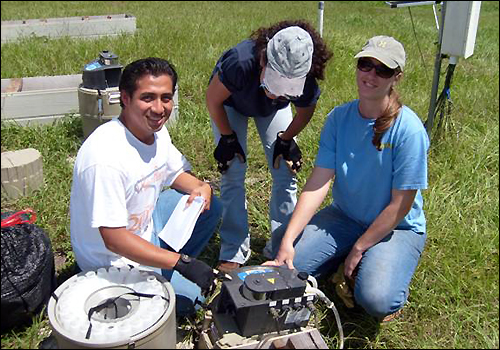A Flexible Numerical Component to Simulate Biogeochemical Transport Processes Through Vegetative Filter Strips
Participants: Oscar Perez-Ovilla, Rafael Muñoz-Carpena (UF)
Timeline: February 2006 – December 2009 (Field Study), May 2008 – May 2010 (Data Analysis and Modeling)
Funding Agencies: Florida Department of Environmental Protection - Bureau of Mine Reclamation, UF Water Resources Center (FL-WRC)
Project Summary
Vegetative Filter Strips (VFS) are one of the most widely recommended best management practices (BMP) by many state and federal agencies to control non point-source pollution from disturbed land areas. Removal of pollutants in vegetative filters depends of various factors including: field runoff characteristics, site conditions, VFS design, maintenance (Muñoz-Carpena et. al. 1999 and 2004). However, most of the schemes or procedures currently used to design VFS are based on the empirical approach. Since the application empirical approach is limited to very specific conditions, its applicability to more complex or variable scenarios could underestimate or overestimate the VFS surface needed to remove the pollutants. Consequences of this include a poor removal of the pollutant, more land surface, more human and economical resources to install and maintain the VFS, among others.
In order to understand the dynamics of runoff pollutants through VFS to better predict the efficiency of pollutant removal in different scenarios (climatic, scale, length, slope, vegetation in VFS, soil, etc), a "generic pollutant transport module" has been added to the VFSMOD-W program. VFSMOD (Carpena et. al. 1999) is one of the programs recommended by the Environmental Protection Agency and other federal and state agencies to design VFS. The generic module is developed based on the numerical solution of the 1-D Advective-Dispersive equation using a standard Bubnov-Galerkin cubic/quadratic finite elements method, and then coupled with a flexible biogeochemical multi-species reaction module (RSE) (James et. al., 2009). The advantage of the coupled component is that pollutants of very different types can be simulated with the same program through conceptual models defined through the XML user interface.

For the testing stage of the program, analytical and lab and field scale experiments are used. For the lab experimental testing, the program was used to explain the results of Yu (unpublished, 2009), where a tracer travels in surface runoff over a sand bed. For the field scale experimental testing, the model was used to simulate the removal of phosphates and particulate phosphorus in runoff from phosphorus mining areas in South Florida.
The positive implications of this novel approach are that transport and fate dynamics of specific pollutants (either physical, chemical or microbiological) in VFS and natural areas of dense vegetation can be readily modeled. It is expected that the approach will serve as an exploratory tool for researchers and to develop simplified models to support environmental decision-making.
Project Impacts
Research findings can be used to help users such as researchers, environmental agencies, and other to design the optimal characteristics of vfs for removing pollutants. Additionally, it helps to researchers to explore the different elements and interactions between the pollutants and the filter strip.
Resource Links
- Field scale experimental data at phosphate mining areas in Bartow, Florida.
- UF-HydroBase
Publications
- Ritter, A., R. Muñoz-Carpena and O. Perez-Ovilla. 2007. An Inverse Calibrator for VFSMOD-W Using the Global Multilevel Coordinate Search/Nelder-Mead Simplex Algorithm[185KB]. ASAE Paper No. 072212. St. Joseph, Mich.: ASAE.
- Perez-Ovilla, O. and R. Muñoz-Carpena. In preparation 2010. A flexible modeling approach for transport and reaction of pollutants in runoff.
- Perez-Ovilla, O. and R. Muñoz-Carpena. In preparation 2010. Simulation of tracers and nanoparticles in surface runoff using a flexible modeling approach.
Technical Reports
- Muñoz-Carpena, R., O. Perez-Ovilla and Y. Li. 2008. Field and Data Maintenance of the FL-DEP BoMR Vegetative Filter Strip Research Facility in Homeland, Bartow (FL)[1.18MB]. Final Project Report to the Florida Department of Environmental Protection-Bureau of Mine Reclamation, DEP DEP Order No. 798181. August 2008. University of Florida: Gainesville.
Presentations & Posters
- Perez-Ovilla, O. and R. Muñoz-Carpena. 2009. Thinking and modeling out of the (black) Box: An example using Vegetative Filter Strips for runoff pollutants modeling. Annual Meeting of the American Society of Agricultural and Biological Engineers, Florida Section, July 2009, Daytona Beach, FL.
- Perez-Ovilla, O. and R. Muñoz-Carpena. 2008. A generic approach for simulating pollutant runoff dynamics in Vegetative Filter Strips. Annual Meeting of the American Society of Agricultural and Biological Engineers, Florida Section, June, 2008, Duck Key, Florida.
- Perez-Ovilla, O. and R. Muñoz-Carpena. 2008. VFSMOD-TARSE: A generic Approach for Simulating the Removal of Runoff Pollutants in Vegetative Filter Strips. The University of Florida Water Institute First Symposium: Sustainable Water Resources: Florida Challenges, Global Solutions. February, 2008, Gainesville, Florida.
- Perez-Ovilla, O. and R. Muñoz-Carpena. 2007. Development of a Generic Pollutant Transport Component to Simulate Runoff Pollutant Dynamics Through Vegetative Filter Strips. Annual Meeting of the American Society of Agricultural and Biological Engineers, Florida Section, St. Pete, Florida.
Courses Taught
- Muñoz-Carpena R and O. Perez-Ovilla. Taller: Introducción a los Modelos de Hidrología y Calidad del Agua para el Control de la Contaminación de Escorrentía Superficial (Workshop: Introduction to the Models of Hydrology and Water Quality for the Control of Pollution in Surface Runoff). Universidad Autónoma de Chiapas, November, 2008, Mexico.
This page was last updated on July 13, 2019.